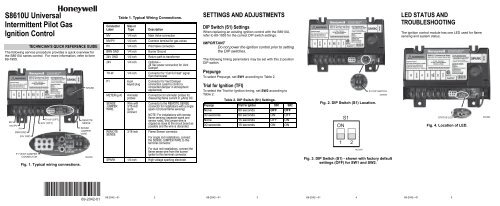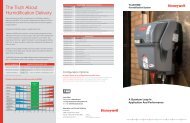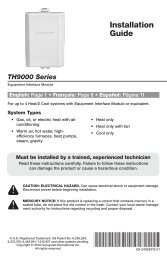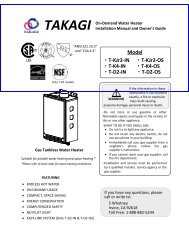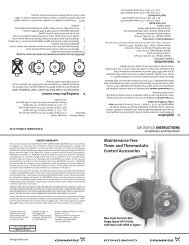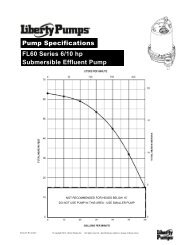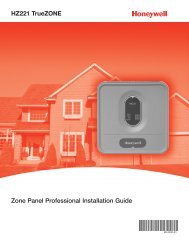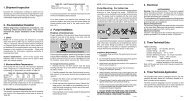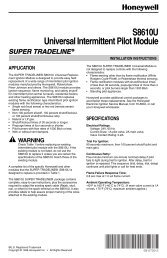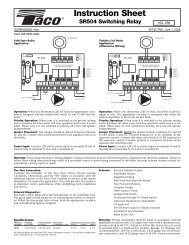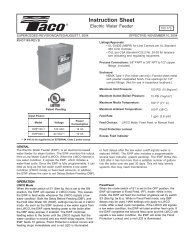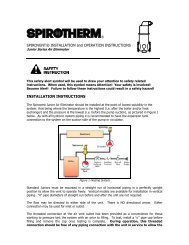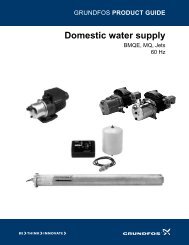69-2042—01 - S8610U Universal Intermittent Pilot Gas Ignition Control
69-2042—01 - S8610U Universal Intermittent Pilot Gas Ignition Control
69-2042—01 - S8610U Universal Intermittent Pilot Gas Ignition Control
Create successful ePaper yourself
Turn your PDF publications into a flip-book with our unique Google optimized e-Paper software.
<strong>S8610U</strong> <strong>Universal</strong><br />
<strong>Intermittent</strong> <strong>Pilot</strong> <strong>Gas</strong><br />
<strong>Ignition</strong> <strong>Control</strong><br />
TECHNICIAN’S QUICK REFERENCE GUIDE<br />
The following service procedure provides a quick overview for<br />
the <strong>S8610U</strong> series control. For more information, refer to form<br />
<strong>69</strong>-1955.<br />
MV<br />
MV/PV<br />
PV<br />
BRN/GND<br />
24V GND<br />
P1 VENT DAMPER<br />
CONNECTOR<br />
TH-W (OPT.)<br />
24V (OPT.)<br />
Fig. 1. Typical wiring connections.<br />
SPARK<br />
REMOTE<br />
SENSE<br />
SENSE<br />
JUMPER<br />
WIRE<br />
M29890<br />
<strong>69</strong>-2042-01<br />
Connector<br />
Label<br />
Table 1. Typical Wiring Connections.<br />
Size or<br />
Type Description<br />
MV 1/4 inch Main Valve connection<br />
MV/PV 1/4 inch Common terminal for gas valves<br />
PV 1/4 inch <strong>Pilot</strong> Valve connection<br />
BRN GND 1/4 inch Burner Ground<br />
24V GND 1/4 inch Return path to transformer<br />
24V 1/4 inch Optional—<br />
24 Vac power connection for Vent<br />
Damper<br />
TH-W 1/4 inch Connector for “Call for Heat” signal<br />
from thermostat<br />
P1 6-pin<br />
keyed plug<br />
Connector for Vent Damper<br />
connection (used to control a<br />
connected damper in atmospheric<br />
appliances)<br />
METER (μA) Ammeter<br />
probes<br />
Connection for ammeter probes for<br />
measuring flame current in μAmp DC.<br />
SENSE<br />
JUMPER<br />
WIRE<br />
Wire with<br />
3/16 inch<br />
quick<br />
connect<br />
Connects to the REMOTE SENSE<br />
connector for installations with a single<br />
spark rod (local flame sensing)<br />
NOTE: For installations with remote<br />
flame sensing (separate spark and<br />
sensor rods), this jumper wire is<br />
clipped as close to the circuit board as<br />
possible and the wire is discarded.<br />
REMOTE<br />
SENSE<br />
3/16 inch Flame Sensor connector<br />
For single rod installations, connect<br />
the SENSE JUMPER WIRE to this<br />
terminal connector.<br />
For dual rod installations, connect the<br />
flame sense wire from the burner/<br />
igniter to this terminal connector.<br />
SPARK 1/4 inch High voltage sparking electrode<br />
SETTINGS AND ADJUSTMENTS<br />
DIP Switch (S1) Settings<br />
When replacing an existing ignition control with the <strong>S8610U</strong>,<br />
refer to <strong>69</strong>-1955 for the correct DIP switch settings.<br />
IMPORTANT<br />
Do not power the ignition control prior to setting<br />
the DIP switches.<br />
The following timing parameters may be set with this 2-position<br />
DIP switch.<br />
Prepurge<br />
To select Prepurge, set SW1 according to Table 2.<br />
Trial for <strong>Ignition</strong> (TFI)<br />
To select the Trial for <strong>Ignition</strong> timing, set SW2 according to<br />
Table 2.<br />
Table 2. DIP Switch (S1) Settings.<br />
Prepurge Trial For <strong>Ignition</strong> SW1 SW2<br />
None 90 seconds OFF OFF<br />
30 seconds 90 seconds ON OFF<br />
None 15 seconds OFF ON<br />
30 seconds 15 seconds ON ON<br />
Fig. 2. DIP Switch (S1) Location.<br />
S1 DIP SWITCH<br />
M29894<br />
Fig. 3. DIP Switch (S1) - shown with factory default<br />
settings (OFF) for SW1 and SW2.<br />
LED STATUS AND<br />
TROUBLESHOOTING<br />
The ignition control module has one LED used for flame<br />
sensing and system status.<br />
Fig. 4. Location of LED.<br />
<strong>69</strong>-<strong>2042—01</strong> 2 <strong>69</strong>-<strong>2042—01</strong> 3 <strong>69</strong>-<strong>2042—01</strong> 4 <strong>69</strong>-<strong>2042—01</strong> 5<br />
S1<br />
ON<br />
1 2<br />
M23587<br />
STATUS LED<br />
M29896
Table 3. Green LED Status Codes.<br />
Green LED<br />
Flash Code a<br />
Indicates Next System Action Recommended Service Action<br />
OFF No “Call for Heat” Not applicable None<br />
Flash Fast Power up - internal check Not applicable None<br />
Heartbeat Normal startup - ignition<br />
sequence started (including<br />
prepurge)<br />
Not applicable None<br />
4 Seconds ON<br />
then “x” flashes<br />
Device in run mode. "x" = Not applicable<br />
flame current to the nearest<br />
μA.<br />
None<br />
2 5 minute Retry Delay Initiate new trial for ignition after retry delay If system fails to light on next trial for ignition check gas supply,<br />
– <strong>Pilot</strong> flame not detected completed.<br />
pilot burner, spark and flame sense wiring, flame rod<br />
during trial for ignition<br />
contaminated or out of position, burner ground connection.<br />
3 Recycle<br />
Initiate new trial for ignition. Flash code will If system fails to light on next trial for ignition, check gas supply,<br />
– Flame failed during run remain through the ignition trial until flame is pilot burner, flame sense wiring, contamination of flame rod,<br />
proved.<br />
burner ground connection.<br />
4 Flame sensed out of<br />
sequence<br />
If situation self corrects within 10 seconds,<br />
control module returns to normal sequence. If<br />
flame out of sequence remains longer than 10<br />
seconds, control will resume normal operation 1<br />
hour after error is corrected.<br />
Check for pilot flame. Replace gas valve if pilot flame present. If<br />
no pilot flame, cycle “Call for Heat.” If error repeats, replace<br />
control.<br />
5 Damper Error:<br />
– Damper required but not<br />
If damper error corrects, ignition control<br />
resumes normal operation.<br />
Check damper connection, damper wiring, and 24V connection<br />
on control.<br />
present<br />
– Damper failed to open<br />
within 60 seconds<br />
– Damper failed to close<br />
within 60 seconds<br />
Replace damper if necessary.<br />
6 <strong>Control</strong> Internal Error <strong>Control</strong> module remains in wait mode. When the Cycle “Call for Heat.” If error repeats, replace control.<br />
fault corrects, control module resumes normal<br />
operation.<br />
7 Flame rod shorted to ground <strong>Control</strong> module remains in wait mode. When the Check flame sense lead wire for damage or shorting. Check<br />
fault corrects, control module resumes normal that flame rod is in proper position. Check flame rod ceramic for<br />
operation.<br />
cracks, damage or tracking.<br />
8 Low secondary voltage <strong>Control</strong> module remains in wait mode. When the Check transformer and AC line for proper input voltage to the<br />
supply<br />
fault corrects, control module resumes normal<br />
operation.<br />
control. Check with full system load on the transformer.<br />
a Flash Code Descriptions:<br />
- Flash Fast: rapid blinking.<br />
- Heartbeat: Constant ½-second bright, ½-second dim cycles.<br />
- 4-second solid on pulse followed by “x” 1-second flashes indicates<br />
flame current to the nearest mA. This is only available in run mode.<br />
- A single flash code number signifies that the LED flashes X times at 2<br />
Hz, remains off for two seconds, and then repeats the sequence.<br />
Fig. 5. Measuring flame current with micro-ammeter.<br />
<strong>69</strong>-<strong>2042—01</strong> 6 <strong>69</strong>-<strong>2042—01</strong> 7 <strong>69</strong>-<strong>2042—01</strong> 8 <strong>69</strong>-<strong>2042—01</strong> 9<br />
P1<br />
+<br />
FLAME<br />
–<br />
PRE<br />
PURGE<br />
30 SEC<br />
CURRENT<br />
0 SEC<br />
STATUS<br />
P1<br />
+<br />
–<br />
TRIAL<br />
FOR<br />
IGNITION<br />
15 SEC J1<br />
90 SEC<br />
PRE<br />
PURGE<br />
FLAME<br />
30 SEC<br />
CURRENT<br />
0 SEC<br />
STATUS<br />
TRIAL<br />
FOR<br />
IGNITION<br />
15 SEC J1<br />
90 SEC<br />
002.3<br />
µA<br />
DC<br />
M31283<br />
FLAME CURRENT MEASUREMENT<br />
Flame current of the device can be meaured using a standard<br />
micro-ammeter by simply inserting the meter probes into the<br />
holes labeled FLAME CURRENT, as shown in Fig. 5.<br />
• Flame current must be measured with pilot valve lit but no<br />
main gas flowing.<br />
• Disconnect MV leadwire from the control before measuring<br />
flame current.<br />
• Set meter to DC μAmp scale.<br />
• Ensure meter leads are positioned correctly [+/-].<br />
NOTE: Trying to measure the pilot flame current in series with<br />
the wiring will not be accurate.<br />
Recommended Minimum <strong>Pilot</strong> Only Flame Current:<br />
• Must read steady 1 μAmp DC minimum.<br />
• Flame current should be 2 μAmp or greater for reliable<br />
appliance operation.<br />
Automation and <strong>Control</strong> Solutions<br />
Honeywell International Inc.<br />
1985 Douglas Drive North<br />
Golden Valley, MN 55422<br />
Honeywell Limited-Honeywell Limitée<br />
35 Dynamic Drive<br />
Toronto, Ontario M1V 4Z9<br />
customer.honeywell.com<br />
® U.S. Registered Trademark<br />
© 2010 Honeywell International Inc.<br />
<strong>69</strong>-<strong>2042—01</strong> M.S. Rev. 09-10<br />
Printed in U.S.A.


